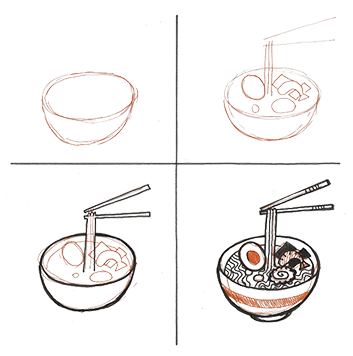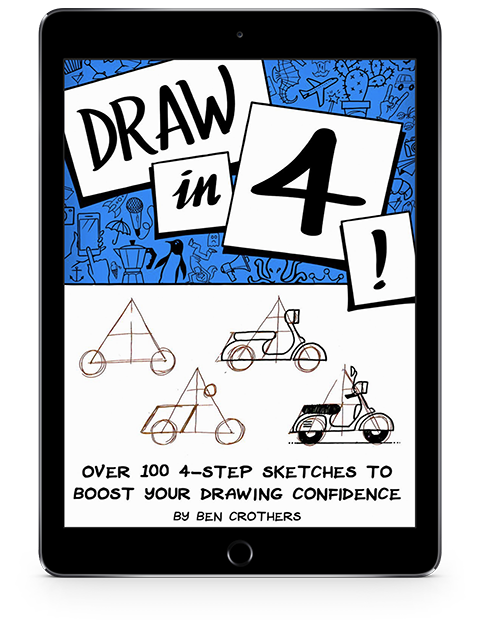If you struggle to draw from imagination – or even what’s right in front of you! – the foundation lines drawing technique is made for you. Try it yourself, and gain greater confidence and ability, with more satisfying results.
[UPDATED] Quite a while ago I was filling my Presto Sketching Instagram account with a big collection of 4-step how-to practice drawings, like this one:

I started doing these ages ago, as a way to build a visual library of things that were (and still are) useful to mentally ‘reach for’ when sketching at work. This is handy for journey mapping, graphic recording, sketchnoting, storyboarding, or anything else where you need to communicate ideas and messages to others. I still do a lot of these during any training sessions I do about drawing, but especially back then I added a lot to Instagram, and then made an e-book out of 100 of them, called Draw in 4.

Extra plug: If black-and-white e-book doesn’t suit your style, you can also get the deluxe colour PDF version of Draw in 4 here.
These 4-step drawings use a technique in Chapter 6 of the Presto Sketching book, called foundation lines (or construction lines) as a way to increase ability and confidence in sketching. And it goes a bit like this:
- Look at the object you want to draw, and in your mind’s eye, break it into basic geometric shapes. I recommend doing this with objects in front of you first, before trying to do it from imagination.
- Draw those basic shapes with a light-coloured pencil or marker (or a very thin marker). The shapes themselves shouldn’t be perfect; it’s perfectly fine to draw them a few times, to help you place them right where you want them to go. My dearest old art teacher used to call this “finding the line”.
- Once you’re happy with the main shapes, draw in any more lines that help to give you more guidelines to draw over, such as the lines indicating the ramen contents and chopsticks in the example above.
- Now, start drawing with your darker marker, over the top of those foundation lines. You’ll see how the dark marks spring forward, and the lighter, coloured lines recede.
- Finish your drawing with any detail you like. Sometimes it’s nice to add some shading or colouring using the colour you used for the foundation lines.

Nice, hey? By breaking anything down into shapes first, you help your mind observe, deconstruct, and then reconstruct the object for you to draw, to get a much more satisfying result.
I love this technique because it gets you to exercise a part of drawing that doesn’t get enough air-time: your observation skills. In other words, really seeing and paying attention to what you want to draw is just as valuable as how you end up drawing it.
Once you sketch anything using foundation lines a couple of times, your mind’s eye automagically ‘sees’ the foundation lines on the paper, tablet or whiteboard, and you can then draw whatever the object is with more confidence. You can also develop your own style, based on a more solid understanding of what it is you want to show.

I hope these examples tempt you to try this method yourself, the next time you draw. Before long, you’ll be able to sketch up an ice cream, a moped, a kraken — or whatever it is you want to draw — in no time at all!